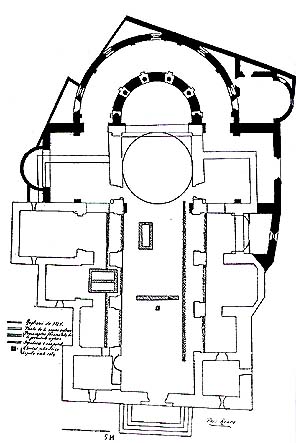Parish history

11th century
The present temple of San Pedro de Rubí comes from the extension of a pre-Romanesque temple built very probably during century X, at the same time as the castle of Arab origin located to the outskirts of the urban helmet. The bell tower and the west window still have elements of the old pre-Romanesque temple.
The church square, Doctor Guardiet Square, was already occupied during Roman times as evidenced by excavations and archaeological finds during the last century: there was a medieval necropolis on the south side of the temple under the current square , With graves of the paleo-Christian period (S. V).
The earliest document referring to the temple dates from the year 986. By the eleventh century the church was already considered the Parish, it was consecrated on February 28 of an exact year yet to be determined. Numerous writings of personal donations have been found in the neighboring Monastery of Sant Cugat where it is stated that the goods are destined to the Rubinian Parish. These evidences, and especially that which records the abbot Ramon de Sant Cugat bequeathed in favor of Guillem Berenguer lands adjacent to the parish of San Pedro de Rubí seem to indicate that, under the protection of the Castle and the church, grew and developed the Population of Rubí.
At the end of the s. XI was rebuilt the pre-Roman building in a Lombard Romanesque style, as we can see in the west façade. It is possible that the plant would then also be provided in the form of a Latin cross. The most important elements of this time are the twinned window, made with elements from the previous church, and the Lombard armories. During the s. XII was carried out some reforms, among which we emphasize the Romanesque portico of the facade of west attributed to the School of Barcelona.
Between the XV and XVI centuries the bell tower was built. Around the temple a community of homes was formed that constituted the municipality of Rubí. The local council (the local government of the moment) met in front of the temple.
16th century
Since the s. XVI lateral chapels will be established on the sides of the central nave. The first documented is the one that was dedicated to the Verge of the Roser, in 1577. It took charge of her the Confradía of the Mare de Déu del Roser.
At the beginning of the s. XVII the municipal council commissioned the sculptors Francesc and Jaume Rubió, father and hijp, who were from Moià, to make an altarpiece for the church, the pieces that remain of the altarpiece can be seen already restored in the Chapel of the Santísimo.
During the War of the French, specifically in 1809, the temple was sacked by the Napoleonic troops, who also stole numerous objects of value.
Between 1883 and 1884 were carried out the works of expansion of the eastern facade of the building. The dome was also built at the junction of the two ships. The architect in charge of the project was Antoni Casademunt.


20th century
In 1927 beautification and repairs were carried out: new benches, tiles and glass; Repair of tiles and other details ..., thanks to Dr. Guardiet. The planimetry of the Romanesque building elaborated by Roura draws a building oriented from west to east, with a Latin cross plan, a nave with pointed vault vault and rectangular transept and apse. The side walls of the pre-Romanesque nave had been opened in order to give access to the chapels. For this reason, the walls of the original construction have become pillars that finally define a three-nave enclosure.
On July 20, 1936 a band of uncontrolled people set fire to the church and many objects of religious worship were burned by the flames. During the civil war, the bells were cast to manufacture war material and the temple was used as a warehouse for the agricultural union.
On February 29, 1939, the first Mass was held after being closed to worship for 30 months. The building is being rebuilt step by step after the war. Also they charge normality the celebrations and Religious celebrations. The altars were restored. Rafael Solanic sculpted the image and the altarpiece of San Pedro that can contemplate at present, besides other artistic elements located in the side chapels.
During the 1990s, the battlements of the bell tower were restored.
Source

If you want to dedicate some time
to helping with the parish activities contact us.
If you don't have time and you prefer donating,
now you can do it occasionally or on a regular basis. Access the donate section for further information.

